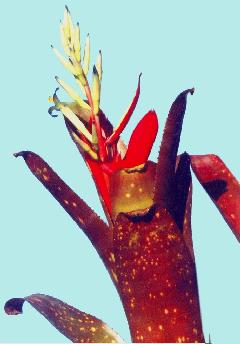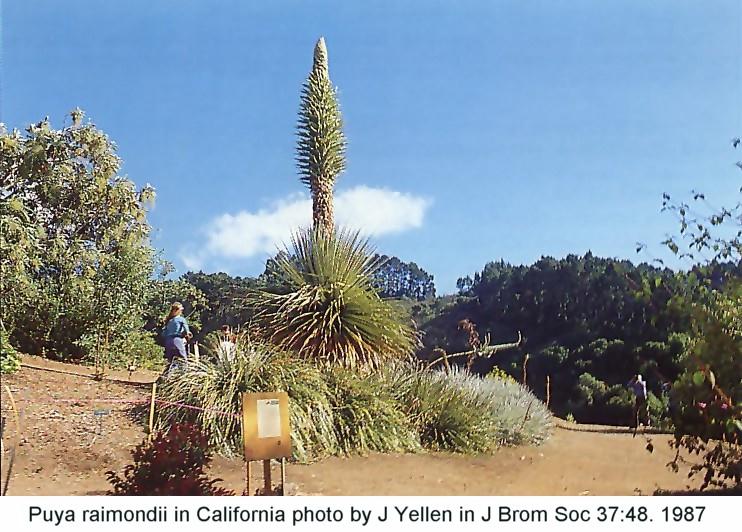
Coming Events.
May 7th Derek and Len on the Tillandsia symposium at Albury at Easter.
June 11th Billbergias.
July 9th Len Colgan on Bolivian tillandsias in Powerpoint.
A Butchers trip to the Adelaide Botanic gardens on Feb 14th.
After having had our van considered to be a Contractor’s vehicle and being shouted morning coffee we were allowed to start work.
First we did see what was left of the Puya garden – 3 rather forlorn Puya raimondii. I have decided that now you can see the ‘trees’ instead of the forest of puyas that these plants could well be the ones I gave to the Gardens so many years ago. They had been raised from seed from Karel Knize in the1980’s and you never knew when Karel had put the wrong name on the seed packet. The plants have remained solitary and this, plus the dead ends to the leaves suggest the name is correct. Plans are that one of those special tree lifting machines will be used to help in a temporary move for these plants. Instead of being part of a jungle perhaps in the future they will get more chance to expand and even be flowering size in another 20 years. For those who do not know, this species flowers and dies BUT you get millions of seeds and have to wait another 30-40 years for your seedling to flower. It is interesting that such a plant is treated by AQIS as a weed. I would love to know their definition of a weed. To my mind it is ANY plant that gets out of control where you do not want it! I think Puya raimondii would take many many years to become a weed!

Back to the Brom house where John Sandham was waiting with his lists. Botanic Gardens love lists! They call them accession lists but they don’t seem to delete accessions when they die! We were reminded of our trip to the Singapore Botanic gardens where they too had lists of their bromeliads. In fact, they had three. The first was done when they first received the plants, the second was an inventory done some 5 years later without reference to the first list because those doing the inventory did not know how to identify bromeliads, and a third one done by the current bromeliad curator. Deaths had not been marked, but when this culling was done the lists became more manageable. It did not take long before John Sandham’s lists had lots of ‘D’s on them!
When talking of lists we must remember that some of our members do this including George Rudolph and Bill Treloar but I wonder how conscientious they are when finding a death and noting it in their records. I’ll bet the answer is, “leave it to later!”
Carolyn was in charge and we quickly decided that the best way to tackle the problem of plant identity was to start at one end until we had finished!!! Why were we doing this? The plants were being moved out to temporary homes until the super duper new complex is finished. Only the Pitcairnia seemed to need special conditions whereas all the others could be accommodated in some shady place somewhere in the gardens, AND what better time to make an inventory than just prior to moving. We pointed out that the Tillandsias could go outside too but had to be high enough out of reach of human crows and remembered to be watered.
One thing did strike us straight away was the use of old names. We decided we would not confuse them with this aspect at this time. You would have noticed labels in Botanic gardens show more details than you find on plants at a bromeliad meeting and if you are stubborn you could follow the Botanic gardens protocol. For example Nidularium billbergioides (Schultes f.) L B Smith 1931 is just as valid as Canistropsis billbergioides (Schultes f.) Leme 1998 because they apply to the same plant, but the latter date shows the current thinking. This non-changing of labels might well reduce the number of complaints about name changes but means a lot more work and writing of detail on the label!
It was clearly survival of the fittest where the offsets of the original plant had moved it to a position where it could expand. No potting-on of offsets here! It was just like what they would have to do in the jungle. Those that did not fight for space just died! It was interesting to see some species with long stolons that were not evident at least in the Butchers’ collection. It was surprising how many identities we were able to work out without the flower but it needed discussion. Carolyn was uncomplaining as she moved amongst the plants in her boots and shorts. It was only after an hour or so that she mentioned that perhaps long trousers would have been better. BUT it did give her an idea as to which were Aechmea and which were Vriesea!
We feel sure we missed some plants but have set up a line of communication where we may be able to help with identification if more plants are found when they are removed for transport elsewhere. We do know that the hybrids they have will be de-accessioned because a Botanic garden should be concentrating on species. We were pleased to see so many of Peter Huddy’s plants that he donated to the Gardens 5 years ago thriving, although not quite up to the standards that Peter set for his private collection.
Finally I must report that the general Puya removal and planting in temporary beds seems to have been a success.
The moving of the 3 Puya raimondii was completed with the special equipment with due fanfare because a reporter and photographer from the ‘Advertiser’ were present and an article did appear later in the Advertiser. We had felt that this moving was sufficiently moving from the emotional point of view that it needed publicity. So it was gratifying that our suggestion to John Sandham came into fruition.
March meeting held in February from the Secretary’s desk!
Because of State Elections, Womadelaide, Car Racing, Horse racing, etc and our own Show, March was rather full up so we had the meeting the last weekend in February! Perhaps members don’t read newsletters because membership was down and we could not complain about the weather.
Adam did his usual job in encouraging comment as he went through the plants brought in by members as being worthy of a brag or two.
Nidularium ‘Ruby Lee’ is not an easy plant to grow here although there are times when you can produce a good specimen and Margaret Butcher had managed that for at least this season. Some learnt that this was the name given to a variegated plant and to call the plant ‘Ruby Lee Variegated’ was a sort of tautology. If it did lose its variegation it would be called ‘Ruby Lee’ Novar but that’s another story! Next there was the almost black leaved Nidularium ‘Nana’.
The only Billbergia was a B. ‘Xmas Cheer’ originating in Western Australia and was in flower and fruit. The keen grower would have noticed that it was one of those hybrids obtained by crossing two subgenera of Billbergia. In other words the watchspring petalled sort with the just plain coiled sort! The petals were certainly not coiled up tight so there was some evidence of the crossing was successful. The other clue was that seed was setting. This is something you rarely see in the common Billbergia – hands up those who have seen a seed pod on Billbergia nutans for example. Yet you often see seed on say Billbergia brasiliensis. Talking of which Dave Wecker had brought in a batch of 3 month old seedlings growing like the wind! We were able to tell Dave that the growth rate would diminish greatly with winter!!
Dave’s and Adam’s guzmanias brought up a discussion on the pluses and minuses of watering in the hot weather. Is there an ideal time? Bill Treloar of Bute was stongly advocating that his weather – up there – is 2 or 3 degrees hotter which when we hit 40C is an appreciable difference, He sits on his hands and waits for the cool change to really get here before watering. We must remember that he does bury his pots and his Tillandsias must weather the conditions. Dave Wecker has only Adelaide weather to contend with and not only are most of his pots at ground level but he has lots of shade.
I and others have found out that you do not water in the middle of the day on these sorts of days because you seem to get boiled plants. However, Peter Huddy had a sophicated very fine missing system that he swore by in reducing temperatures very quickly.
Admittedly I am mainly a Tillandsia man but I follow the premise that the coolest time of the day is just after dawn where in nature, dew is likely to occur giving drinks to tillandsias. So if I hear any high forecast out comes the hose for a bit of splashing around.
Now to potted plants which in nature are likely to be epiphytic too and do not need as much water as we possibly think. We base our belief on the large plants they get in Queensland but what with water restrictions here you must cut your cloth accordingly. As soon as warm weather starts it does not take too long for the soil in the pot to dry out and on watering the water stays in whatever leaf funnel nature has provided but generally goes very fast past the soil out the holes at the bottom. You can slow this down by the use of saucers or the like underneath. If the saucers are too deep you can get a build up of salts where the water in the plant itself tries to dilute the water in the soil. Here your soil looks moist but the plant becomes dessicated! So you do need some way of changing the water to balance things up. I only use small plastic plates which are sufficient to stop some water run off but if it rains it does not take long to get an overflow. If any of you have experienced better ways of watering your plants please drop me a note. Always remember that tank rain water is always better than tapwater which by April/May is becoming somewhat salty!
There were several vrieseas in flower including Vr. ‘Sunset’. If you are ordering Vr. ‘Sunset’ by name make sure it is the one linked to Kent!
Then to the neoregelias. There was ‘Homage’ which is a fairly recent Grace Goode hybrid. I only got detail of this last month from Grace. It certainly has good colour. The variations in the ‘Bobby Dazzler’ on display made me think of happenings in Townsville where Rob Smythe has named ‘Patchwork’ for a mutation where even more variations had occurred.
The Tillandsia stand provoked interesting discussion. Were the 3 T. fasciculata brought in by Len having been collected in Florida and Cuba just to the south really all var. densispica? Does Len Colgan really have T. occulta with branched inflorescence? Or are his all simple spiked?.
I was pleased to see a flowering T. esseriana on display because there are now at least 3 living specimens of this rare species in Adelaide.
Colours
Bill Treloar talked about his Tillandsia velickiana having white petals in the hot Summer and the normal blue in the winter. I felt he had to be talking about two different plants because certainly my tillandsias do not have that long a flowering period and who ever had plants that could change petal colour! He had no photographic proof to back up his statement. He was only going on memory! Recently on the Internet I was asking about blue petalled Tillandsia usneoides as stated by Lyman Smith in Flora Neotropica which all learned Bromeliad growers should know about and refer to. So Eric Gouda sent me a blue petalled T. usneoides which looked awfully like the green petalled one except for the colour. He even sent me a red petalled one for good luck. Others on the NET got snitchy because they did not believe that a taxonomist could be the jokey sort! Jokes aside, let us get serious. One of the bits of information I was given in my bromeliad early years was that vrieseas did not like to flower in the really hot weather and we have found that this is the case. In January after the really hot spell our Vriesea ‘Voodoo Magic’ squeezed out a flower so I could photograph it. The stamens were visible so it appeared to be a ‘proper’ flower. The petals were red as you see in Vriesea glutinosa but we could not find this species in the alleged parentage which is a complicated one. The leaves are almost black which did not seem to be a hereditary trait either. So, on March 4th when Margaret said our ‘Voodoo Magic’ had yellow flowers I gave her the same answer as Bill! Alas, she was right as she usually is and I took a photo in case Bill did not believe me. This phenomenon may only occur with very hot dry days to set up some imbalance in the plants reproductive organs so Adelaide (and places in the near north!) may be the only place where these funny things happen. BUT they do need to be recorded.
Talking of heat I don’t think others around Australia realise about dry heat. It has been said by a Townsvillean that “boiling bromeliads is a myth” .If you are foolish enough to water in the middle of one of our really hot days you get parboiled or blanched leaves as stated in all recipe books!
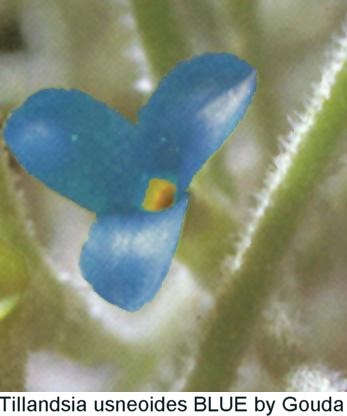

Internet.
I had an interesting phone call from a Lloyd Godman, an ex Kiwi now living in Melbourne. He is a Brom grower with a difference and grows them for much different reasons than any of us. He considers the leaves are great with great variation. He sticks cut out patterns on leaves and exposes them to controlled light. We all know from experience that if you just expose them to light they will BURN! If it is controlled light they turn various shades of red. When he thinks they are cooked enough he removes the patterns and his creative photography comes into play. If you are the arty type you may wish to visit his fledgling web site at Lloydgodman.net
A third Aussie to be botanically recognised
The common denominator – mathemathically speaking – is Len Colgan.
You may remember years ago that Len convinced me to send a bit of his Puya that I had grown from seed to Harry Luther for identification. It took over a year and after consultation with Lyman Smith. It was called Puya butcheriana. Puyas are notoriously difficult to identify because of their size, prickly nature and habitat so isolated, collection of specimens for herbaria was a rare occurrence. In 2002 Pierre Ibisch and Roberto Vasquez after much field work and studying what was held in herbaria decided to correct past errors in interpretations of Puya humilis and P. tunariensis. In the revamping they realised that P. butcheriana was really a P. humilis. The dried arrangement in Selby Gardens herbarium will still bear the name P. butcheriana to await future investigations!
In 1993 Len Colgan went on a collecting trip to Bolivia with 3 Germans which meant he did not say much! He found lots of plants and felt there had to be one that was different enough to be a new species. He convinced Renate Ehlers that the smallest one there was different and Renate named Tillandsia colganii. This is rare in the wild AND in collections but is moving around slowly.
In 2006 we received the July/August 2005 issue of Journal of the Brom. Soc and we saw Orthophytum schulzianum named after Rudolf Schulz of Teesdale, Australia. Rudolf is a cactus man with an interest in the genus Copiapoa. 30 years ago this was my interest and I wrote a paper on the subject which is now part of a Website in the UK. Rudolf is soon to publish a book on the same genus later this year. Teesdale IS IN Victoria and Len Colgan knows all about it because he always calls in there when returning from seeing the ‘Crows’ perform in Melbourne. He calls in there because Rudolf grows prickly terrestrial bromeliads and Len can’t stop buying them! These are mainly Orthophytum because this genus grows with cactus in Brazil. Regrettably Orthophytum schulzianum is not in Australia. If it were it would be a great challenge and probably need a heated glasshouse for winter. What is strange is that Rudolf did not know that he was having a plant named after him and we had to supply him with a copy of the Journal.
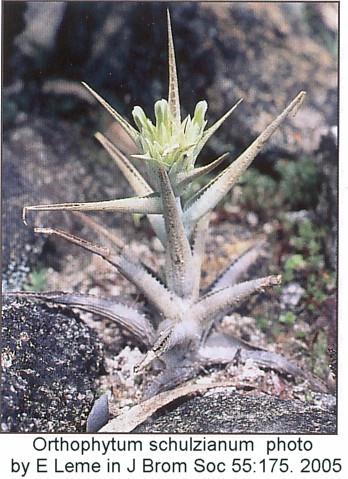
March Show
Some like it hot! The last series of newsletters have discussed the pros and cons of hot weather and meetings. When you have Shows you just have to grin and bear it . 38.5C is HOT and when you see plant purchases go out of the door you give as much warning to their new owners as you can. Leaves touching glass can burn but even more so with touching metal. Then warning that as soon as they get home to put the plants temporarily in a real shady place. Mind you if they do mess up, bromeliads are resilient enough to come good after a while. I had thought that the hot weather would have meant more attendees on the Sunday because this was overcast and REAL Brom. weather. Alas, it was not the increase I had envisaged.
Expecting the people rush we experienced at our last two shows we had encouraged two of our Victorian members to come over for the weekend so the reduced attendance due to the heat had us extra worried! Despite the large reduction in people through the door we collected $7600 in plant sales over the weekend which compares very favourably with previous efforts.
Winners of the plant competitions were as follows
Josie Tonkin Trophy – Tillandsia stricta by Derek Butcher
Margarete Reppin Trophy – Dyckia ‘Warren’ by Len Colgan
President’s Trophy – Quesnelia marmorata by Bill Treloar
Gummow Trophy –Billbergia ‘Hallelujah’ by Len Colgan
Marie Robinson Trophy – Tillandsia mooreana by Mick Romanowski
Neoregelia Trophy – Neoregelia ‘Heinz’ by Bill Treloar
Ed Schaefer Trophy – for Champion of all sections – Quesnelia marmorata by Bill Treloar.
For those who read Newsletters from other societies it may be of interest to show how differently we operate. There are no sections! All plants put into the display in groups of genus and are all judged according to the rules but there would not be any ‘Not according to Schedule’!! Because all members can enter, this includes judges. This is why we have a panel of judges to see fair play although I would suggest a judge would judge his/her own plant more critically than another person’s! The panel this time comprised of Alf Carr, Adam Bodzioch, Margaret Butcher, David Wecker, and Bev Masters. Each has equal voting rights and I have been advised that input by the newer judges was appreciated. We thank them all for accepting the challenge.
I know we infrequently read our Constitution (which I have on my computer if anyone wants a copy) but the Objectives are
A To achieve the highest standards in methods of cultivation of the Bromeliaceae
B To acquire and disseminate information regarding these plants and to encourage their propagation.
C To co-operate with similar bodies of mutual interest.
Every member should have these objectives, not just the Secretary, although he would be more involved in “C”, and “B” because he is the Editor. “A” should be evident in the number of members putting plants in for display to at least show we are getting somewhere. We know there were some 120 plants in the display but 50 had been brought in by the Butchers and 30 by Bill Treloar from Bute. How do we encourage members in the belief that they too are growing good plants?
This same sort of apathy also seems to be there in members not bothering to come to the show. Do they want to be involved? Should we allocate jobs so they feel involved? All difficult questions.
Let us now move to more happier things. We were very pleased in the work done by the volunteers who worked over the weekend. We won’t mention names but they will know who I mean. Not only did they work but helped reduce the number of plants on the sales tables!
Visitors. First we saw Maurice Kellett from Vic helping us set up on the Friday afternoon. The other two, Chris Larson and Mick Romanowski were there too but were busy unpacking plants. We were very appreciative of their efforts because many of the plants they brought were not normally seen here. I usually say it takes a year for Melbourne plants to get used to Adelaide conditions, 2 years for Sydney and Perth, 3 years for Brisbane and 4years for Cairns. Some turn out to be annuals where we only flower them once and offsets do not appear!!! We did know that Chris is a vegetarian and had prepared ourselves for this but we did not know that Mick was a consumer of iced tea!
Sunday saw Keith Golinski from Bromagic, Queensland blow in. I knew that Keith might make a visit and previously I had pointed out that we grew a wide range of Bromeliads in Adelaide (quality not quantity) whereas they only grew Guzmania, Vriesea and Aechmea hybrids in Queensland. He pointed out that they weeded in Queensland! This meant he received the Butcher Banter on arrival even though the doorman was supposed to be busy!
Another visitor was an ex Kiwi mentioned in the March report, Lloyd Godman. He left us two booklets promoting his work. I was in a bit of a quandary as to where would be the best place for these booklets because they were more orientating to art forms rather than plant forms. When our Seaton High School liaison Officer – Dave Wecker - pointed out that this was the thing that Art classes in High Schools were doing these days, I had found the ideal place. If any of you are into this sort of thing or know of a School that may be interested and want to learn more of these techniques, then you know where the books are.
Chris and Mick stayed at our place and the first night was uneventful because both were tired out. Saturday night was a bit different because both had been invited to Adam Bodzioch’s daughters 21st party. As to be expected with names like Bodzioch and Romanowski both got stuck into the vodka which I am told exascerbates snoring. So in the middle of the night Chris moved out of the spare room into the lounge. Sunday night was Mick’s turn in the lounge and even the dog came to sleep in our room. Still, they said they had a great time in Adelaide and the food was fantastic!
Pricklies
It was great to see 4 new members at the meeting. New members are the life blood of any Society and there are so many benefits that are available. Perhaps the most important one is wanting to be involved because that way you learn more. When you stop learning you may as well decide right now to leave for that great bromeliad hunting ground in the sky! I have grumbled ( I know – I love doing this!) about the problems of our mailing system to warn Bromeliad growers of pending Shows. This does ensure a good attendance and sales but does the attendance at a Show or the purchase of plants really teach? I know that I get my kicks by investigating plant identity but that is only one facet of learning. So it is great we are getting some to commit themselves to the self satisfaction of learning!
April meeting from the Secretary’s desk
We decided on this topic because here we could recommend plants that will endure the hot summer days without too much protection by planting in outside rockeries. While these plants can endure the heat care must be taken with plants in pots that are exposed to the sun. Here the plant can take the heat but the soil in the pots can cook the roots! So take care in the positioning of your pots. For example a pot within a pot can have an insulating air space between. A gardener with green fingers looks at these small details!
Pricklies by their very nature are rarely collected in this form in the wild or imported for that reason! Most new acquisitions are grown from seed with the adherent problem of unintentional hybridisation. Growers of plants from seed whether hybridists or not must always be prepared to examine their results and not take the word of the name on the packet. Seed production is Nature’s way to reproduce and hybridisation is a part of evolution.
I would like to digress here a moment. Len Cork brought in some seedlings of Neoregelia correia-araujoi and everyone had the opportunity to take home a few plants FREE. I said nothing at the time because nobody likes to be part of an experiment. I will now let you into a secret. The seed came from Florida where two clones of this species was crossed which would tend to reduce the chance of foreign pollen complicating the experiment. Previous growing of seed from this species has produced plants that looked like N. correia-araujoi, N. marmorata and N. johannis. It is my belief that this shows that N. correia-araujoi is a natural hybrid between N. marmorata and N. johannis. Seed obtained from a hybrid gives plants that range between the two parents concerned. The plants that we got into Australia at that time were on the large side. This current seed batch came from smaller versions of N. correia-araujoi and while we may get 3 different sorts of progeny, I am hoping that we may get a small version of N. correia-araujoi.
This experiment will last another 3 or 4 years to get the plants flowering and decisions made. I am growing on the same seed but I do not want to be the only one investigating this – hence my silence! New members may not yet know the subtle differences between these 3 species but there is plenty of time to learn!
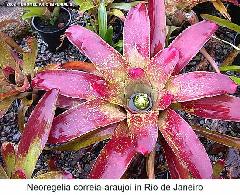
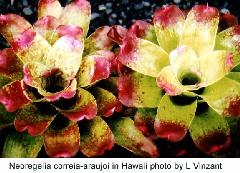
Phew, lets get on to something more reliable! Deuterocohnia which can vary from comfortable looking cushions to quite large flattish prickly bushes. I never tire of telling the story about Len Colgan when on a Tillandsia collecting trip in Argentina yelled for the bus to stop so he could race off to collect a Tillandsia xiphioides. He may have seen the Tillandsia but did not see the Deuterocohnia until he was halfway across. He decided that it was then just as easy to continue! Interesting that he still has an affection for pricklies. I had purposely brought in two cushions of D. brevifolia.
One that originally been collected by Chris Larson and the other I had got from Dutch Vandervort in California. While the Americans call both forms D. brevifolia, I follow the Germans in calling one subspecies chlorantha. As Joan Williams pointed out it takes years to get the cushions of hundreds of plantlets and it pays to protect your investment in this time spent. Care must be taken if the plant is in the open sun on 40C days – Throw over a cloth or something over it, but beware shadecloth which will leave pretty burn mark patterns where it touches. If you forget, expect burning which will take a few years to grow out.
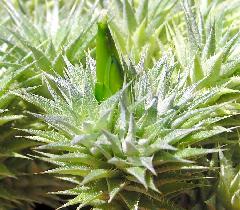
There are a few Orthophytum hybrids about and we saw the old favorite ‘Copper Penny’ with the not so old ‘Starlights’ to the new ‘Warana’ and ‘Stellar Beauty’ than Adam had brought back from Bob Paulsen in Queensland. ‘Starlights’ grows well in Adelaide because of our dry climate. In wetter climes it grows at a fantastic rate and is floppy and light green.
There are 2 sorts of Orthophytum – one we can’t grow and one we can with a bit of luck. The ones we can’t grow centre around O. navioides with its flat shape and red centres but we can grow the bigeneric xNeophytum. The other is Len Colgan’s pride and joy. Some were named, one given a Cultivar name until formally described and one with green flowers found on a Bald Rock that Harry Luther thinks is O. disjunctum var. viridiflorum but Len thinks is something different. One thing you have to be careful with is the way Orthophytum put out their stolons which is invariably down the side of the pot instead of horizontally!
Not many would have seen a Deinacanthion urbanianum and we saw a small one. Len has flowered this species which is closely related to Bromelia and photographs are held to prove the event. When Castellanos wrote about the plant in 1954 he said the local Indians used the plant to make rope and the flowers send forth a nauseous smell! There was an offset poking out from the bottom of the pot if anyone wants to make overtures to Len!
An old favourite with a new name was Ochagavia litoralis. This needs an Adelaide type winter to flower.
Few brought in Puya declaring them too big and prickly. We had a seedling P. mirabilis which is a must for any outside planting. Its lily-like pale green flowers are great. Then thanks to assistance from Andrew Rawlinson we correctly identified a Puya laxa. Mind you, he has a special interest in this plant having successfully bid for this plant at our last auction and it still has not rooted!
The same reason was given for Hechtia and we had Hechtia tillandsioides with its jelly teeth and which we assured was a frustrated male plant because there are no females in Australia.
Encholirium were last but not least. This is a genus that does like it warm in winter and are a challenge. Len had some good specimens but currently unanamed because we are waiting for flowers. However he is fully armed with information because I have gone to the trouble of translating Forzza’s thesis on the genus from Portuguese to English for him. Most are large but there are choice small ones. One of these is E. heloisae that I am currently trying to grow from seed. Even my mate Oscar from Rio de Janeiro says it is difficult!
And so to Adam’s segment on ‘the Others’
Nidularium is genus referred to by Elton Leme as the Guzmania of SE Brazil. In other words, just as showy and easier to grow! We saw N. angustifolium with its large narrow red primary bracts, N. atalaiaense with its coppery primary bracts and a delightful orange bracted plant with the plain name of ‘Species from Brasil’ This last one needs a better name than this and we know it is related to N. innocentii. In all probability the taxonomists would treat this a just one of the forms of this very widespread species but I think it is worthy of a proper Cultivar name. Time will tell.
Billbergia ‘Domingos Martins’ was of interest because it flowered early when it was small. I have always said that the best things come in small parcels and I think this plant was rather cute. This particular cultivar has a habit of doing this. Some may think it is a hybrid but it is a form of Billbergia vittata that the taxonomists considered not even worthy of variety status. Don Beadle and myself decided that somebody had to bite the bullet for a name for this delightful plant.
Three Guzmanias that Adam had brought in showed that this genus can be grown here with a bit of care. Hybrids being much easier than the species.
In the absence of Len ( Crows were calling) the Tillandsia stand was sparse but still interesting. You too can grow T. pruinosa if you persevere. If you went interstate to see rare plants you would not see the T. jucunda var. viridiflora that Bill Treloar had brought in. The challenges of actually flowering T. exserta continues. It is interesting that this plant was shown in the last American Journal having never been featured for the previous 55 years. Perhaps they have difficulty in flowering it too! A T. tricolor var. melanocrater with its dark leaf sheaths was in flower. This form is small growing and yet in Panama where you can find this form and the type they are the same size.
Finally the hybrid T. brachycaulos x schiedeana which was in flower but not showing the typical reddening of the leaves typical of T. brachycaulos. The only certainty was the T. schiedeana because of the yellow petals and its other parent by the telltale bluish colour at the bottom of the petals.
Billbergia ‘Medowie Gift Pinkie’ by Derek Butcher
It is over 25 years now that I started collating Australian Bromeliad hybrids and in the early stages things were rather primitive. They were just lists with parentages and who had done the deed. No photographs or ways of describing plants. In those early years Bill Morris was a prolific hybridiser but was not keen on naming his hybrids. The girls – Olwen Ferris and Grace Goode – got their heads together and we had such things as Neoregelia ‘Bill’s Beauty’. This did not lie too well with Bill and he started to name his own hybrids but not all!
So my pushing for hybrid names to be registered is not new but this is an example of what can go wrong. In 1990 we got several Billbergia hybrids from Bill Morris in Medowie, NSW and, guess what, several were not named and therefore not recorded! He had selected two clones from one batch of an (amoena x ‘Glory Be’) but how long ago he had done the cross or how many offsets had changed homes were unknown. We called the plants ‘Medowie Gift’ and ‘Medowie Gift Pinkie’.
Let us now move to February 2006 where Grace Goode had sent me photographs and requests to register hybrids that she felt worthy of recording.
These days with a super duper data base on the computer I (or anybody) can check for duplicate names and duplicate parentages and lots of other things! Grace had sent me details of an old Bill Morris hybrid that she and Phyll Hobbs wanted to call ‘Pink Pearls’. I stumbled across this old (amoena x ‘Glory Be’) and it seemed that we were not the only ones to have got an offset from Bill in the distant past.
This checking of mine has also revealed possible double entries when hybridists have lodged registration for their new hybrid. When it is revealed that the same parents have been used before I send them a photo of the old hybrid and ask if their ‘new’ hybrid is different. Some, especially at F1 level have agreed to use the old name!! This leads me to another thing we used to do innocently in the past. I know Olwen for one would re-make a hybrid for a named hybrid because she had the parents as stated but not the hybrid. Seedlings were given the old name without checking if they were different!
As you know there are several ‘old’ hybrids still in circulation which were done in Europe in the late 1800’s and which are supposed to have survived two World Wars. I feel sure that some could well be remakes and bear no relationship to the original description or painting. This is an area I call fun!
